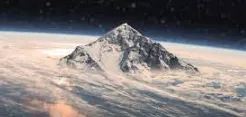Exploring the Tallest Mountains Beyond Earth: A Journey through the Solar System's Giants
Tallest Mountains In the Solar System: A Journey through the Solar System's Giants
Embarking on a thrilling expedition through the cosmos, we uncover the mesmerizing heights of the solar system's tallest mountains.
From the colossal shield volcano of Olympus Mons on Mars to the impact basin of Rheasilvia on Vesta, and the rugged range of Maxwell Montes on Venus, these extraterrestrial giants have captivated scientists and explorers for eons.
Join us as we unveil the remarkable geological wonders that the solar system has to offer.
Olympus Mons - The Martian Colossus
Standing as a testament to the grandeur of Martian geology, Olympus Mons reigns as the tallest volcano and mountain in the solar system, dominating the Martian landscape with its monumental size.
Stretching over 600 kilometers (370 miles) in diameter, this shield volcano reaches an astounding height of approximately 21.9 kilometers (13.6 miles) above the surrounding plains, dwarfing even Earth's Everest.
The awe-inspiring evolution of Olympus Mons spans billions of years, marked by a gradual slope and a vast caldera at its summit, creating a breathtaking scenic plateau unlike any Earthly mountain.
With the absence of tectonic plate movement on Mars, this colossal mountain has withstood the test of time, making it one of the most extraordinary landmarks in our solar system.
Rheasilvia - Vesta's Mighty Impact Basin
Venturing beyond the confines of planets, we encounter Rheasilvia, an impact basin on the asteroid Vesta.
Formed by an ancient asteroid impact, this massive crater spans about 500 kilometers (310 miles) in diameter, with its central peak soaring approximately 22 kilometers (13.7 miles) high.
Rheasilvia's central peak is a testament to the dynamic processes shaping celestial bodies. The colossal impact generated intense heat, causing the rock beneath the surface to rebound and form this towering mountain-like peak.
The ongoing exploration of Vesta and its impact basin continues to unravel valuable insights into the history of our solar system.
Maxwell Montes - Venus' Rugged Range
Venus, the second planet from the sun, boasts its own impressive mountain ranges, with Maxwell Montes standing tallest among them.
This complex system of mountains stretches across nearly 1,200 kilometers (746 miles), with its highest peak rising approximately 11 kilometers (6.8 miles) above Venus' average surface elevation.
The formation of Maxwell Montes remains a subject of ongoing scientific research and debate. Theories suggest that it might have emerged due to the planet's volcanic activity or through tectonic processes.
Despite Venus' corrosive atmosphere and extreme temperatures, the study of Maxwell Montes contributes to a deeper understanding of geological processes on other planets.
Earth's Tallest Peak - Mount Everest
Turning our gaze back to Earth, we encounter Mount Everest, situated in the Himalayas, standing tall as the highest mountain on our planet. Soaring to an impressive height of 8,848 meters (29,029 feet) above sea level.
Everest surpasses all other terrestrial mountains and has been an alluring challenge for mountaineers for over a century.
Mount Everest's awe-inspiring height is intimately linked to the collision of tectonic plates in the region. As the Indian plate continues to push northward, it collides with the Eurasian plate, leading to the majestic uplift of the Himalayas.
Everest stands as a symbol of human endeavor and an emblem of Earth's natural wonders, capturing the essence of exploration and discovery.
Conclusion:
As we traverse through the solar system's celestial wonders, from the towering slopes of Olympus Mons to the vast impact basin of Rheasilvia and the rugged range of Maxwell Montes, we are reminded of the boundless marvels of the cosmos.
These remarkable geological formations offer unique opportunities for scientific inquiry and ignite the indomitable human spirit of adventure and exploration.
Let us cherish not only the extraterrestrial giants but also the majestic beauty and geological wonders that grace our own planet, exemplified by Earth's Mount Everest.
As we continue to venture into the depths of our solar system and beyond, let these awe-inspiring mountains be a testament to the endless possibilities and the captivating mysteries that await us in the vastness of space.
Read Also:
The Northern Lights Display in 17 States in Thursday Solar Storm








Comments
Post a Comment